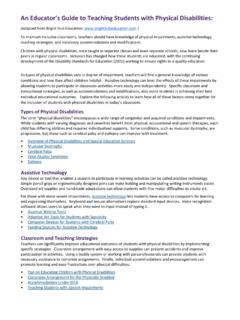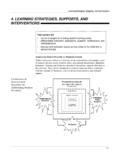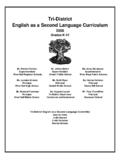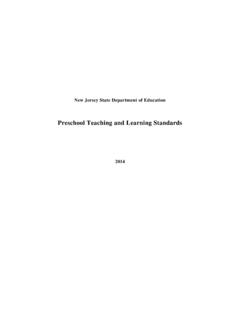Transcription of Classroom Adaptations for Students with Special Needs
1 Classroom Adaptations for Students with Special Needs & Learning Difficulties From a socio-cultural perspective, disabilities do not disappear: rather, the interactions in the Classroom provide a context for abilities to appear for children to develop their individual ways of knowing and learning (Vodd Group, 95) Outlined below are some useful learning strategies that may assist those Students who struggle with their learning, or demonstrate some difficulty with everyday Classroom tasks. Student, teacher and parents must work together to maximize the student s learning potential and to create a positive, productive and successful Classroom community.
2 Remember: Collaboration between home and school will facilitate a successful education for the student. Have effective parent-teacher communication, collaboration, and consistency concerning goals, successes, and problems. Remember that we all learn in different ways and we cannot expect that all Students will respond in the same way to a specific teaching strategy (some different learning styles: auditory, visual, kinesthetic, and tactile). Helping your child to be successful: Consistency and communication between home and school Join the class for field trips and other activities.
3 Stress your child s strengths. Work with your child to develop different ways to eliminate difficulties in learning such as: create an environment that encourages learning, plan activities that compliment their learning, and be active in helping your child solve problems. Gather resources about learning disabilities to better understand . ent ld . how you can be most effectiveEnsure your child understands what their academic difficultiesare. Make a reasonable agreemabout how much time your chiwill spend on homework.
4 Remember that your child s homework is their responsibilityYou are responsible for providing 1 a place and monitoring Consider evaluation alternativprogress. ing: pencils, pens, ruler, , felts, etc. d. ompliment your child on a job well done. earning tips in the Classroom : ing notes from the chalkboard, offer an alternative so ne. dent or lend or e may cause a teacher. es and consider altering them if the student is not their desk or binder. They will be able to keep track of their ear up any difficulties right away and still ent.
5 Es like trally as opposed to writing down all the answers. nt study Read at home if there is no regular homework to be done. Provide your child with the tools they need at home, includeraser, paper, dictionary, thesaurus, calculator Treat your child to a brain break as a rewarC LFor some Students , large assignments can seem daunting and unattainable. Break work into small chunks so that the student can achieve a small amount of success each the student has difficulty copythat the work can still be doFor example: photocopy a handout for the stuyour notes to use.
6 Minimize distractions for the student by placing them in aseating plan away from the temptation of excess chatting, noise or high-traffic areas likwindows thatdisturbance. Review the student s Education Plan and follow through with the recommended learning Adaptations that have been set by the school or former Monitor the learning strategiperforming to his potential. For those Students who require constant reminders about how to follow class procedures, provide them with an enlarged checklist of the daily routine or assignment expectations and tape it onwork more independently.
7 Reserve a daily morning time for checking student planners and homework so that expectations are clear and Students can clwork toward achieving a productive day. If Students have difficulty with cursive writing or printing, provide them with practice strategies, but do not let the difficulty prevent them from completing the assignmUse alternatives such as a computer, scribe or an extension on the assignment. esting a student o Getting organized: Set a routine for homework and consistetime in an area with minor distractions. Discuss time management and meeting deadlines.
8 2 Use a planner or timetable to stay on track and manage assignments. ework is complete ents as much as their troubled areas: keep a positive attitude about their learning. earning in Different Ways: Stop, look, listen, and think before jumping t clarify with your the assignment or Allow time for other enjoyable activities once hom(play a game outside, draw, and bake cookies). Support your child s achievem Lin headfirst. Take the time to think abouwhat is expected andteacher if necessary. Read the question or problem out loud or have someone else read it to you.
9 Draw a picture or make a list ofquestion expectations. re finished your work, check er better. Remember the 5 w s and the h y n, don t play with things at your desk or think about what is to spell a word. For example: because could be BWhen you afor mistakes. Ask yourself questions about the work you are doing. This will help you to rememb(who, what, when, where, why, how). Ask the teacher questions. Listen to the other student s questions. They may be asking the same thing. Really listen when questions are asked and answered.
10 That means paattention to the discussiobeing served for lunch! Use tricks to help your mind remember. Draw a picture or a sentence of a question. Repeat a word over and over to help you remember how to spell it or make up a funny saying oys Eat Candy And Ugly Snake Eyes! Use a tape recorder to record stories. Colour-code your materials using a highlightepen. Draw pictures of ideas. Learn to use the computer word processor. Write in r a journal everyday. Get your thoughts down on paper to help you organize them. sking for Help: ou you ways, ably ask for some probably know the answer, but you are trying to get the work done too quickly.








